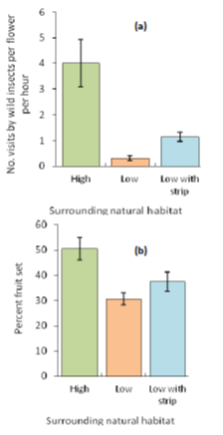Adapted from the articles “Blue Orchard Bees — Potential for Almond Pollination?” by Carolyn Pickel, Area IPM Advisor, Glenn Nader, Farm Advisor Sutter-Yuba and Joe Connell, Farm Advisor Butte County and “Almond orchards with wild insects have higher fruit set” by Claire Brittain, Claire Kremen, Neal Williams, Robbin Thorp, Stephen Hendrix, Alexandra-Maria Klein at Leuphana University, Germany, UC Berkeley, UC Davis and University of Iowa in the Sacramento Valley Almond New, November 2009 and February 2013, respectively.
Blue Orchard Bees
In the late 1970’s and early 1980’s research was conducted on the blue orchard bee at both UC Davis and USDA Logan Bee Biology. Blue orchard bees were determined to be good pollinators for almonds, but there were no commercial suppliers and additional research on handling and timing introduction was needed. Blue orchard bees will never replace honey bees as a primary pollinator, but can enhance almond pollination options and improve nut set and yield when spring pollination temperatures are cooler.
The primary benefit of the blue orchard bee is that they are active at temperatures 2o to 5oF cooler than honey bees. Compared to honey bees, this bee visits fewer flowers per tree, spends less than half the time at each flower or in flight between flowers, and visits more trees across planted rows possibly improving cross-pollination. They can be managed to emerge in synchrony with almond bloom and come back the following year.
For more information on blue orchard bees, download “How to Manage the Blue Orchard Bee as an Orchard Pollinator”.
Wild Insects
Observations of flower visitors in 23 almond orchards in Colusa and Yolo Counties has found that orchards with high levels of wild insects visiting flowers showed increased fruit set. Flower visits by wild insects were positively related to the amount of natural habitat surrounding the orchard.
Almond orchards with high amounts of surrounding natural habitat received many more flower visits from wild insects, predominantly wild bees, than orchards with low surrounding natural habitat (Fig. 1a). The orchards with a semi-natural strip had more wild insect visits than the orchards with low surrounding natural habitat. The same pattern was found with fruit set. Those orchards that had high amounts of surrounding natural habitat and more wild insect visits had greater fruit set (Fig. 1b).

Figure 1. Relationship between natural habitat surrounding the orchard and (a) flower visits by wild insects and (b) fruit set. Columns show average, black bars show variation.
This highlights the benefits of conserving natural habitat within half a mile of almond orchards. Where little natural habitat remains, gains can be made by having a semi-natural strip of vegetation adjacent to the orchard, such as riparian habitat along one edge of the orchard. The degree of benefit these strips bring is likely to depend on how attractive the plants in the strip are to wild bees.


Leave a Reply